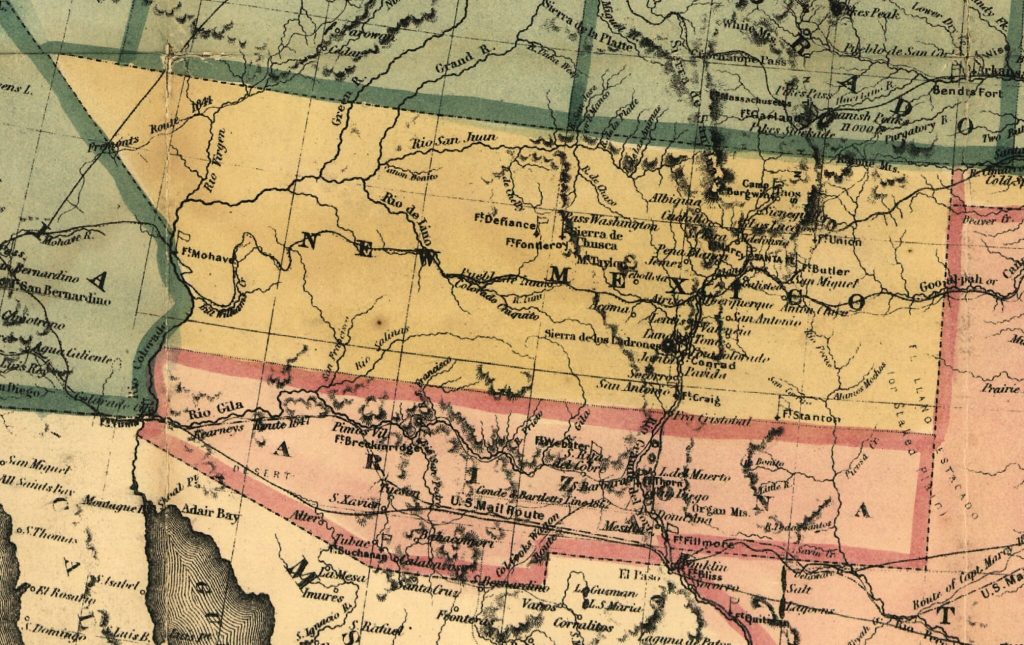“A Very Remarkable Enterprise”: Turning a Desert Into a Garden
On July 12, 1862, the Santa Fe Gazette wrote excitedly about “A Very Remarkable Enterprise” that would bring modern agriculture to what they considered the lifeless wastelands of the Southwestern desert:
“The enterprise in question is no less than that of converting this formidable desert into a fruitful field by introducing water from the Colorado river on and over it, thus causing verdue to replace sterility; the realization of poetic fancy, ‘to cause the desert to bloom as the rose.’” [1]
The Santa Fe Gazette was the paper of record in the New Mexico Territory, which comprised the modern-day states of Arizona and New Mexico. Like many frontier papers, the Gazette was an eager booster for settlement and economic development throughout the region. They also viewed themselves as Westerners first and foremost, at one point even printing a column that dabbled with the idea of seceding along with other western territories to form a Pacific Coast republic (their enthusiasm for secession waned after Confederates invaded and temporarily shut down the newspaper). [2]

In some ways, the idea of turning a 9,000 square mile desert into a veritable garden sounds outlandish, even today – but it’s not that different from what we’ve ultimately done in the region. There’s still plenty of desert in the Southwest, but through aggressive water engineering, we’ve enabled cities and agriculture to grow at a scale that would have exceeded the wildest imagination of anyone in the 19th century. To this day, cotton is one of Arizona’s “Five C’s” and has earned a place of honor on the state seal. [3]
As bold as it may seem to farm a desert without the benefits of modern technology, it was very much in keeping with the spirit of the age. For 1860s Americans, it was in recent, living memory that, from their perspective, they had tamed the wilds of territories like Alabama, Mississippi, Arkansas and Texas, turning them into major contributors to a booming cotton industry.
Southern leaders, many of whom rose to prominence in the Confederacy, had dreamed for decades of stretching their economic and political influence westward. In West of Slavery, Kevin Waite has masterfully documented their decades of efforts to not just open the West, but to specifically open it for an expansion of slavery and plantation economies.
So what does all this have to do with the Civil War?
As secession fever reached its peak, the southern half of the New Mexico Territory declared itself to be Arizona and sought to join the Confederacy. They were quickly reinforced by a few hundred Texans under Colonel John Baylor, followed by 3,000 more under Brigadier General Henry Hopkins Sibley. They had sold President Jefferson Davis on a grandiose vision of a Southwestern expansion of the Confederacy, reaching up into the Rocky Mountain gold fields of Colorado, and westward across the desert to the ports of the Pacific Coast, securing new outlets for slavery and vast mineral wealth for the war effort.
After an early success at Valverde, Sibley’s invasion was ultimately driven back by Coloradans at the battle of Glorieta, and by the harsh realities of campaigning in the desert with little or no logistical support and planning. By mid-1862, New Mexico and Arizona had been secured for the Union for the duration of the war.
It would take another 50 or so years before the dream of a booming Southwestern cotton industry became reality. Outside of a few hundred bales of cotton grown in 1860, the Agricultural Census doesn’t show significant cotton production in New Mexico or Arizona until the early 1900s. [4]
But in many ways, Sibley’s invasion was the culmination – and, if you’ll pardon the pun, the high water mark – of these decades of Southern interest in the Southwest.
[1] “A Very Remarkable Enterprise,” Santa Fe Gazette, July 12, 1862.
[2] “A Very Remarkable Enterprise,” Santa Fe Gazette, November 8, 1860.
[3] “A Cotton Tale,” Phoenix, December 1, 2017
[4] Agriculture of the United States in 1860, Washington Government Printing Office, 1864, 838.
Just what I love: the Civil War and the Wild West!